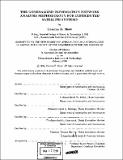The generalized information network analysis methodology for distributed satellite systems
Author(s)
Shaw, Graeme B. (Graeme Barrington)
DownloadFull printable version (24.52Mb)
Advisor
David W. Miller.
Terms of use
Metadata
Show full item recordAbstract
A systematic analysis methodology for distributed satellite systems is developed that is generalizable and can be applied to any satellite mission in communications, sensing or navigation. The primary enabler is that almost all satellite applications involve; the collection and dissemination of information and can thus be treated as modular information processing networks. This generalization allows the adoption of the mathematics for information network flow, leading to a logical classification scheme for satellite systems. The benefits and issues that are characteristic of each system class are identified, in terms of their capability, performance and cost. The quantitative analysis methodology specifies measurable, unambiguous metrics for the cost, capability, performance and adaptability. The Capabilities are characterized by four quality of service parameters that relate to the isolation, rate, integrity and availability of the information transferred between origin-destination pairs within a market. Performance is the probability of satisfying the user's requirements for these parameters. The Cost per Function metric is the average cost incurred to provide satisfactory service to a single user, and Adapatability metrics are sensitivity indicators. Validation of the methodology is provided by a comprehensive quantitative analysis of the NAVSTAR Global Positioning System, in which the calculated capabilities agree with measured data to within 3%. The utility of the methodology for comparative analysis is highlighted in a rigorous competitive assessment of three proposed broadband communication satellite systems. Finally, detailed architectural trades for a distributed space based radar are presented to demonstrate the effectiveness of the the methodology for conceptual design. The generalized information network analysis methodology is thus identified· as a valuable tool for space systems engineering, allowing qualitative and quantitative assessment of the impacts of system architecture, deployment strategy, schedule slip, market demographics and technical risk.
Description
Thesis (Sc.D.)--Massachusetts Institute of Technology, Dept. of Aeronautics and Astronautics, 1999. Includes bibliographical references (p. 287-292).
Date issued
1999Department
Massachusetts Institute of Technology. Department of Aeronautics and AstronauticsPublisher
Massachusetts Institute of Technology
Keywords
Aeronautics and Astronautics